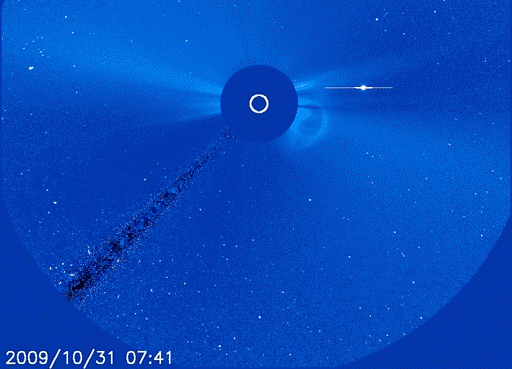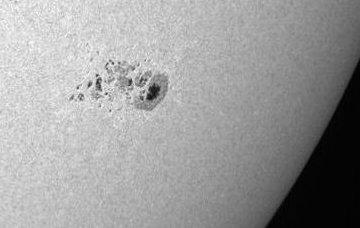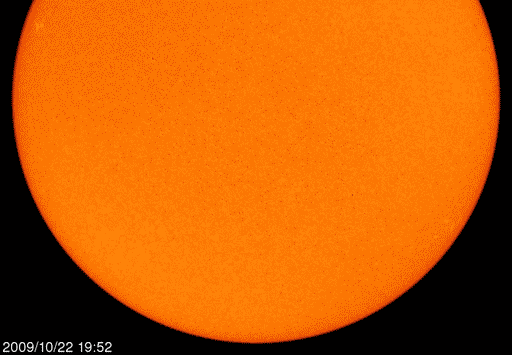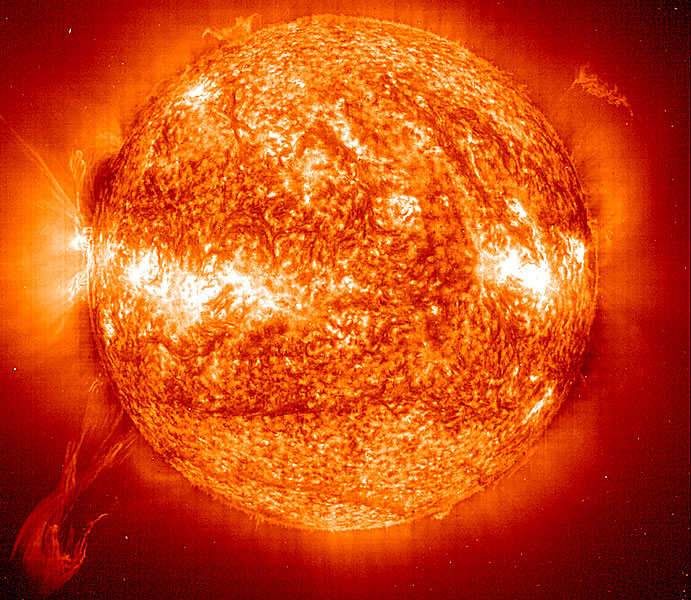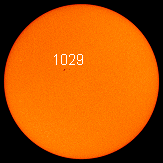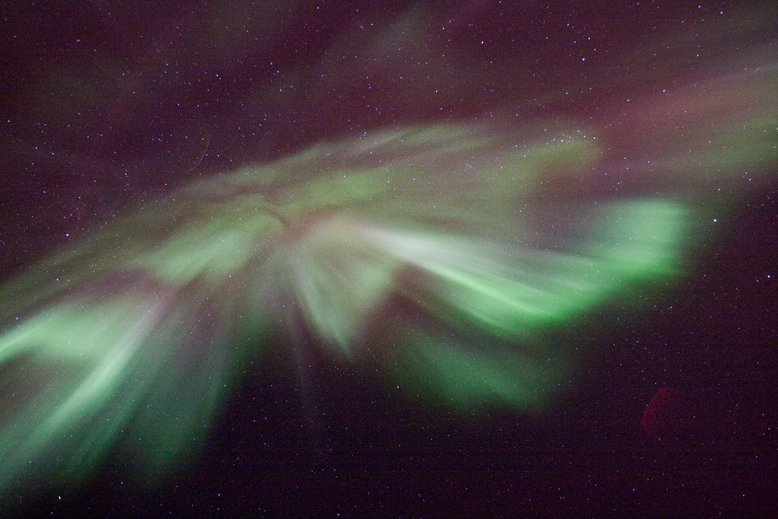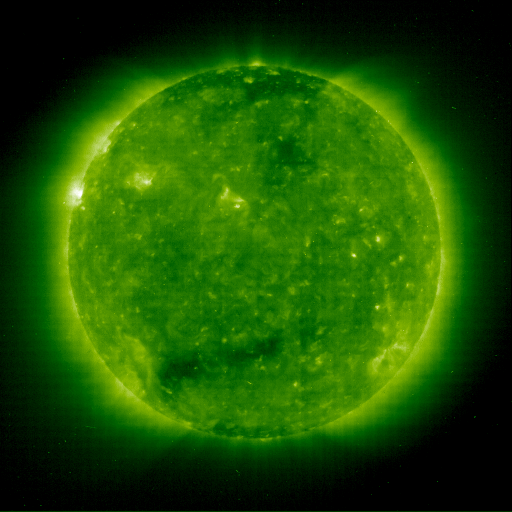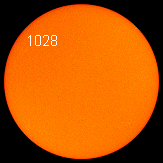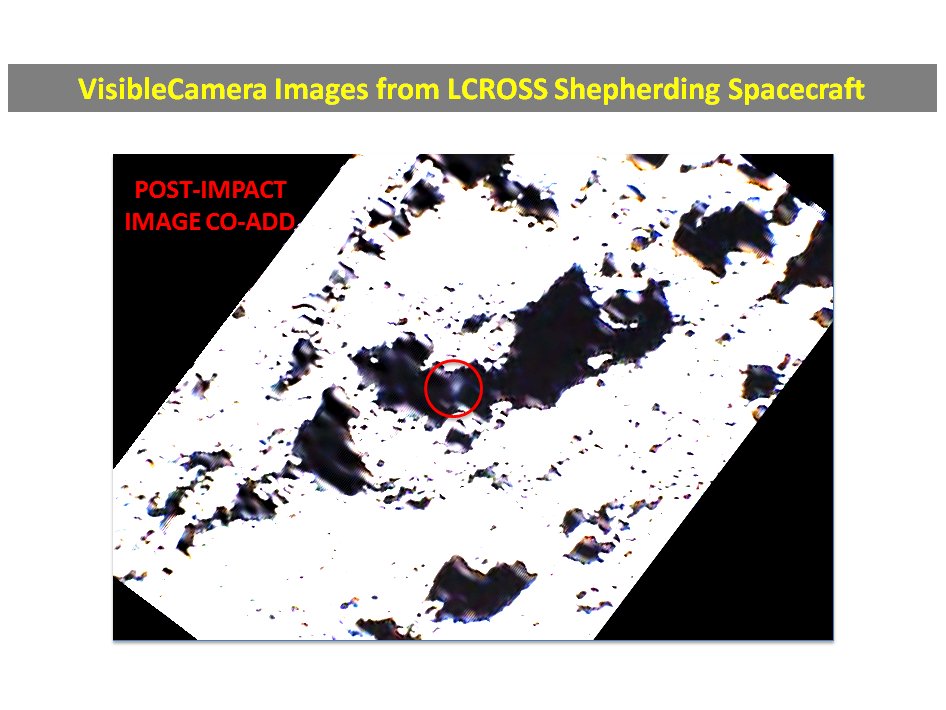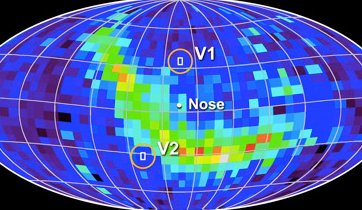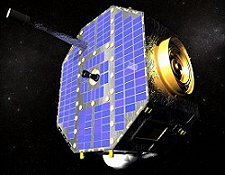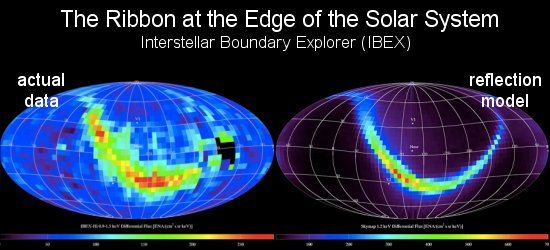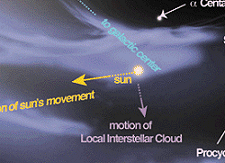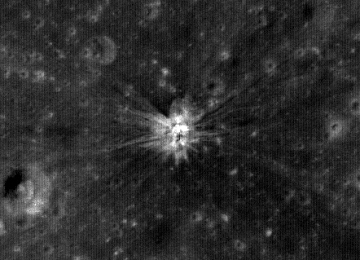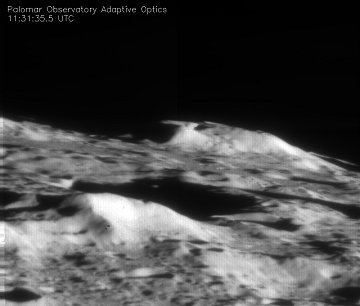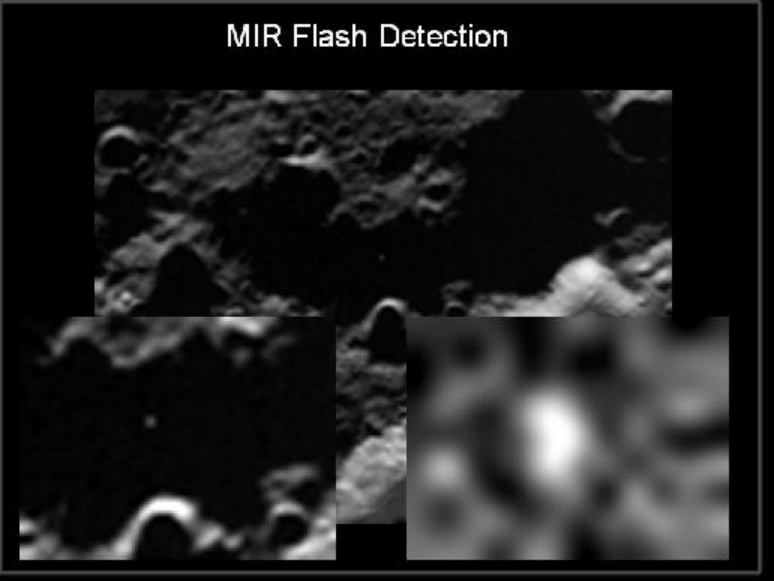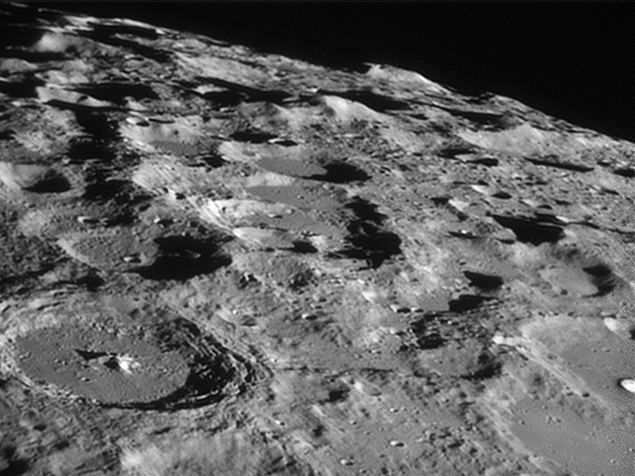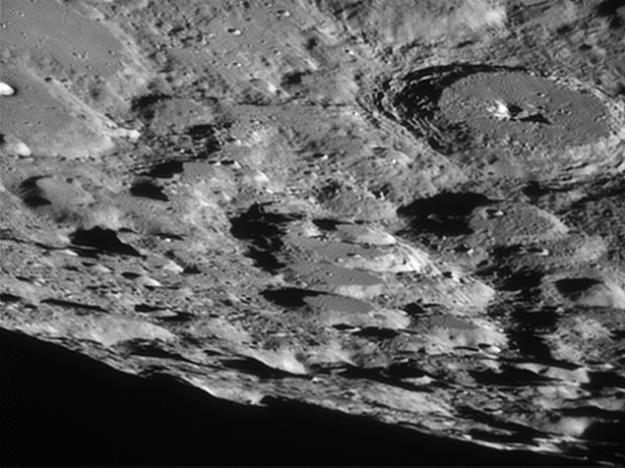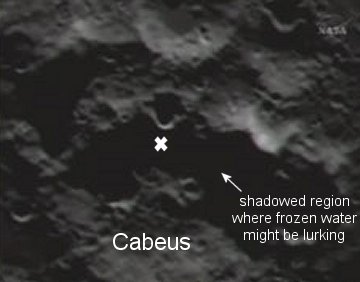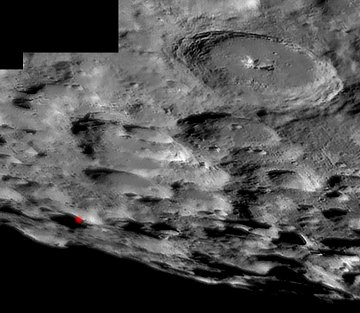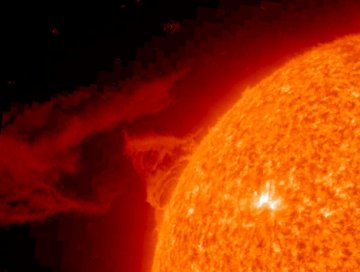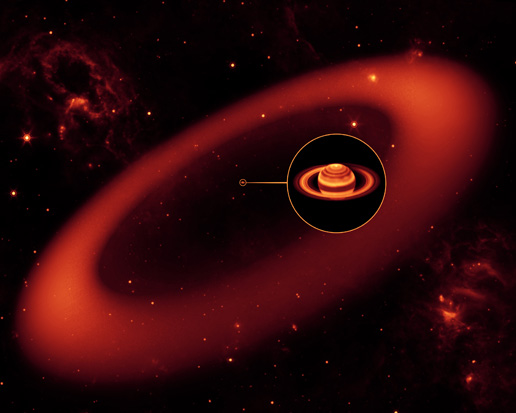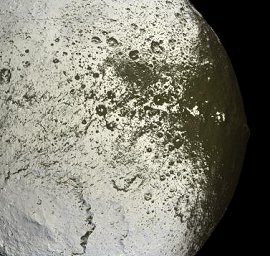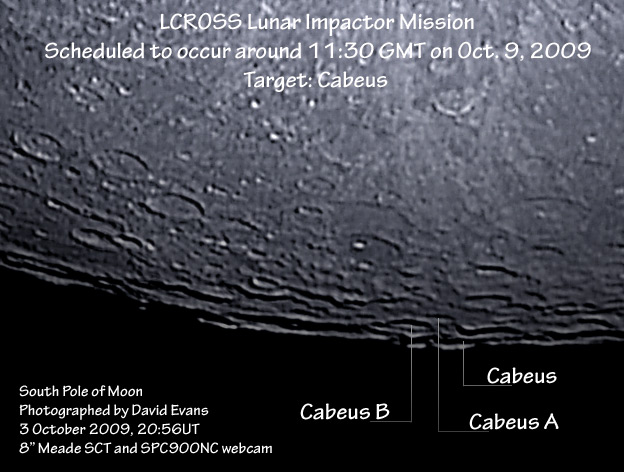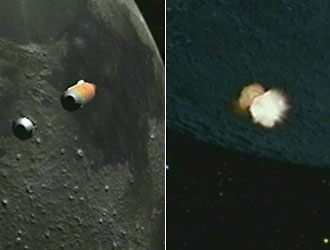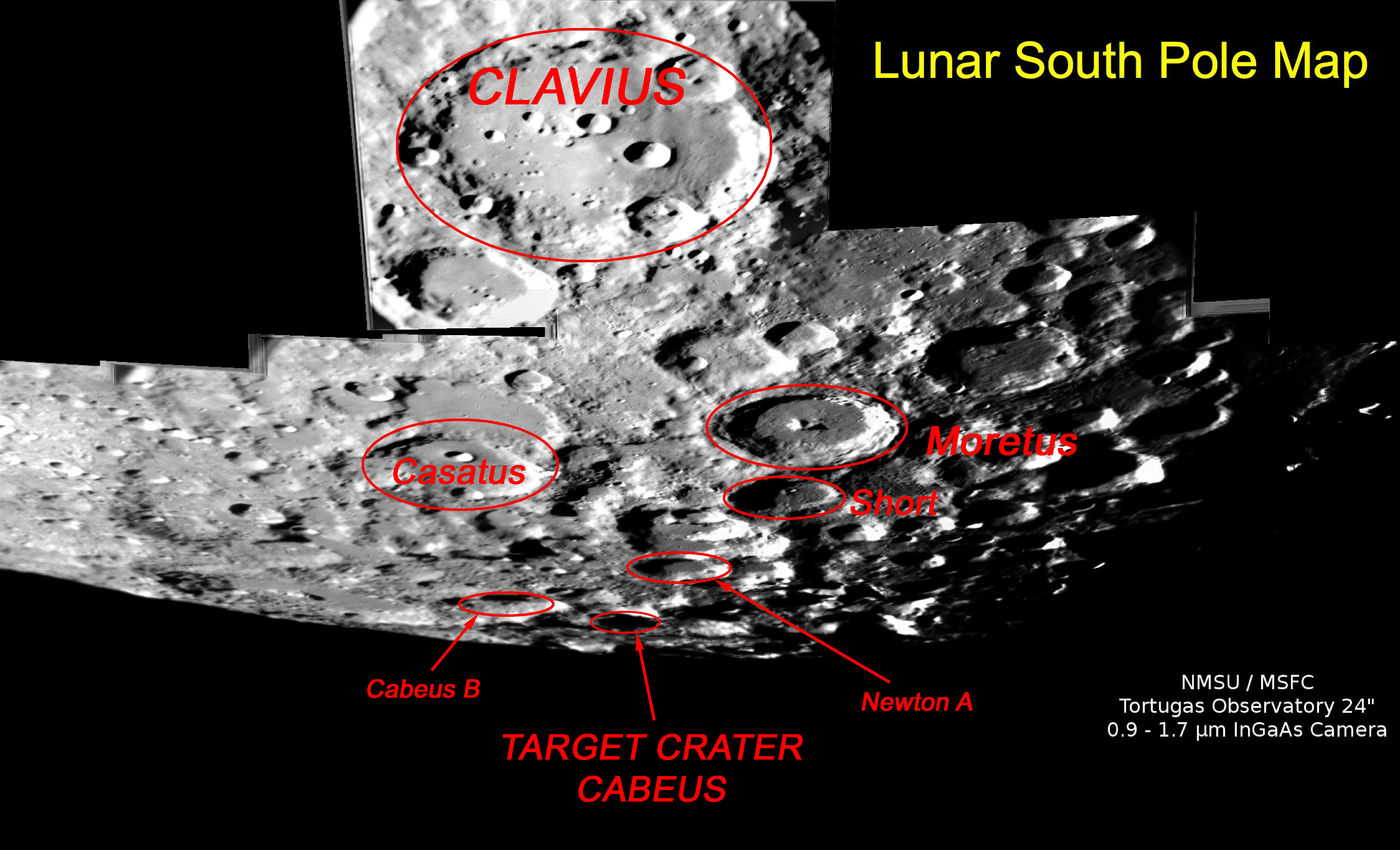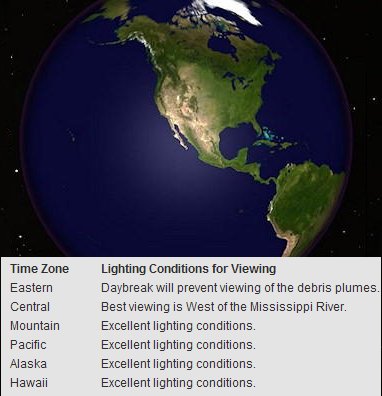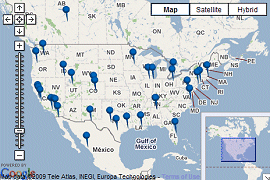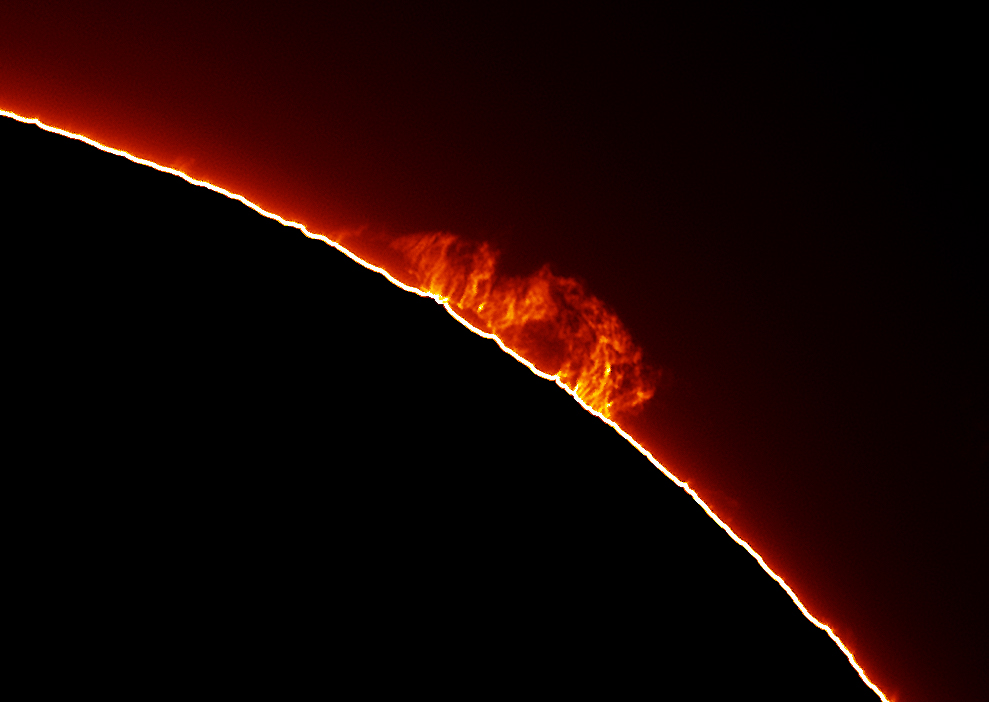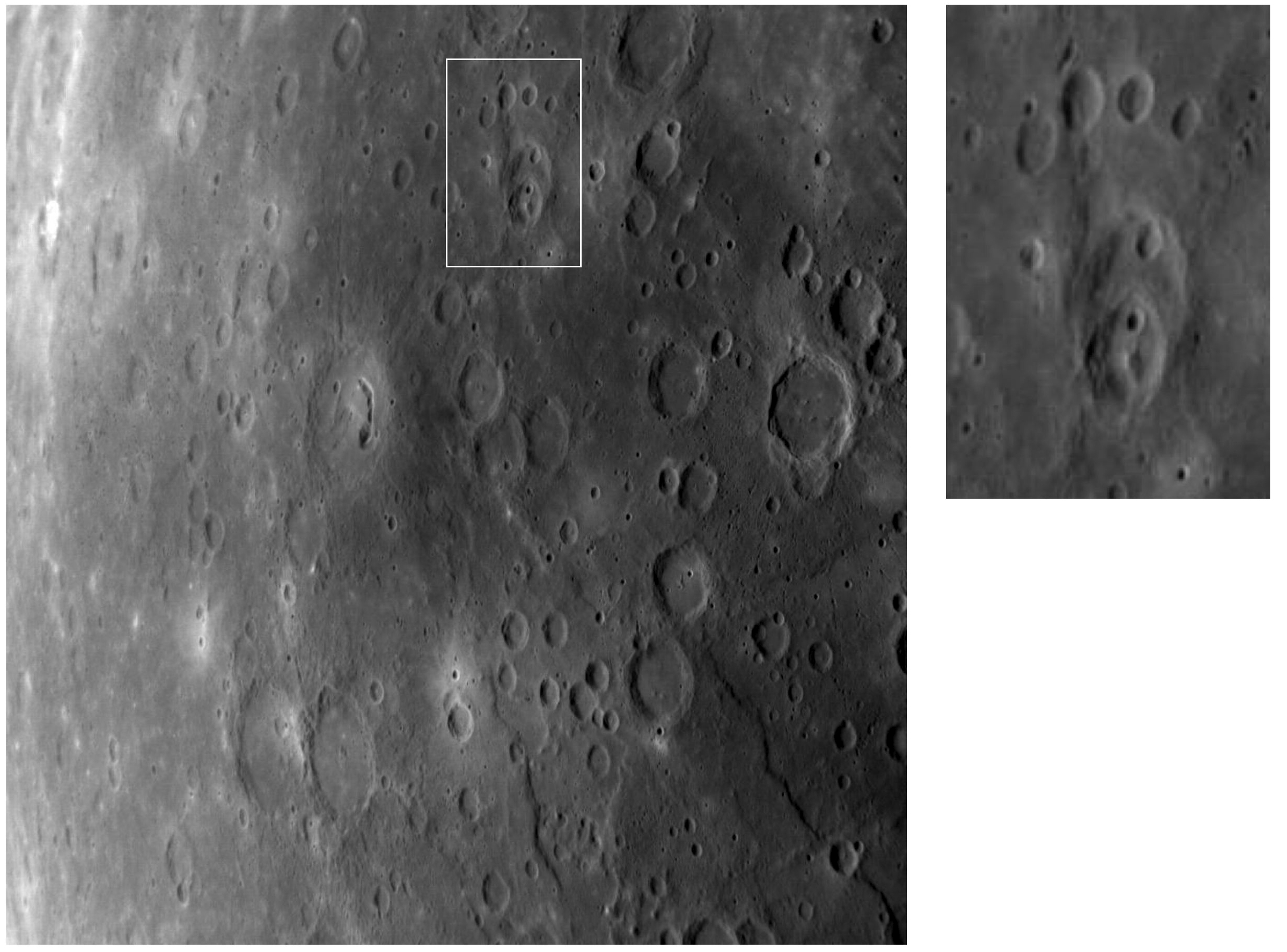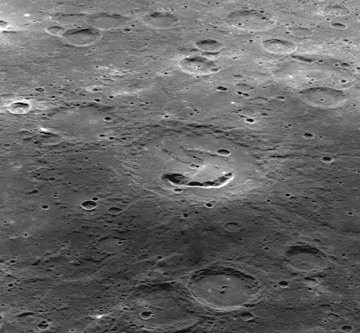| Asteroid |
Date(UT)
|
Miss Distance
|
Mag.
|
Size
|
| 2009 QC35 |
Sept. 2
|
2.9 LD
|
17
|
35 m
|
| 2009 RY3 |
Sept. 11
|
1.9 LD
|
15
|
50 m
|
| 2009 RR |
Sept. 16
|
2.8 LD
|
18
|
33 m
|
| 2009 RG2 |
Sept. 21
|
9.1 LD
|
19
|
31 m
|
| 2009 SN103 |
Sept. 28
|
1.2 LD
|
17
|
13 m
|
| 2009 HD21 |
Sept. 29
|
22.9 LD
|
15
|
1.0 km
|
| 1998 FW4 |
Sept. 29
|
8.6 LD
|
14
|
550 m
|
| 2009 SH2 |
Sept. 30
|
2.8 LD
|
17
|
49 m
|
| Asteroid |
Date(UT)
|
Miss Distance
|
Mag.
|
Size
|
| 2001 CV26 |
Oct. 8
|
9.8 LD
|
13
|
2.2 km
|
| 2009 TJ |
Oct. 13
|
10.8 LD
|
18
|
130 m
|
| 2009 TM8 |
Oct. 17
|
0.9 LD
|
17
|
10 m
|
| 2009 TF8 |
Oct. 17
|
7.6 LD
|
19
|
20 m
|
| 2009 TH8 |
Oct. 19
|
4.5 LD
|
18
|
45 m
|
| 2009 UE |
Oct. 19
|
2.5 LD
|
19
|
40 m
|
| 2009 UD |
Oct. 20
|
2.0 LD
|
17
|
17 m
|
| 1999 AP10 |
Oct. 20
|
29.7 LD
|
13
|
2.7 km
|
| 2009 TO8 |
Oct. 21
|
7.4 LD
|
19
|
27 m
|
| 2009 UJ |
Oct. 22
|
6.8 LD
|
19
|
25 m
|
CURRENT SOLAR FLARE DATA
CURRENT SPACE WEATHER DATA
CURRENT SOLAR X-RAY DATA
LASCO IMAGES
SOHO IMAGES
| 10-31-09 Sunspot - 1029 issues a CME as it moves out of sight
PARTING SHOT:
On its way over the sun's western limb on
Oct. 31st, sunspot 1029 unleashed a
C-class solar flare and a coronal mass ejection (CME).
The Solar and Heliospheric Observatory photographed the
billion-ton CME billowing past Mercury:
The blast reinforces sunspot's 1029's position as the most active sunspot of 2009. Last week alone, the sunspot produced ten C-class solar flares, more than tripling the number of flares in the previous 10 months. Sunspot 1029 is a member of long-overdue Solar Cycle 24. Is it also a herald of more active times to come? Current conditions Solar windspeed: 333.9 km/sec density: 0.7 protons/cm3 explanation | more data Updated: Today at 0319 UT X-ray Solar Flares 6-hr max: B1 2105 UT Oct31 24-hr: C1 0935 UT Oct31 explanation | more data Updated: Today at: 0315 UT
|
||||||||||||||||||||||||||||||
| 10-30-09 - Sunspot 1029 heading for the rim of the sun
Current conditions
Solar wind speed: 350.7 km/sec density: 0.7 protons/cm3 explanation | more data Updated: Today at 2344 UT X-ray Solar Flares 6-hr max: B1 2045 UT Oct30 24-hr: B2 0025 UT Oct30 explanation | more data Updated: Today at: 2340 UT
|
||||||||||||||||||||||||||||||
| 10-29-09 - Sunspot 1029 - leaving us soon
BIG SUNSPOT: After five days of non-stop growth, sunspot 1029 has become the biggest active region of the year and a beautiful target for backyard solar telescopes. Amateur astronomer Lecoq Etienne sends this picture from Mesnil-Panneville, France:
The sunspot's large dark core is about the size of Earth, while the entire sunspot group stretches about 50,000 km from end to end. The behemoth has been crackling with magnetic activity, producing 10 C-class solar flares in the past few days. That more than triples the number of C-flares (3) previously detected in all of 2009. According to NOAA forecasters, there is a 5% chance of an even stronger M-class flare during the next 24 hours. Stay tuned for solar activity! more images: from Dave Gradwell of Near Birr Ireland; from Jimmy Eubanks of Boiling Springs, South Carolina; from Gianluca Valentini of Rimini, Italy; from Peter Paice of Belfast, Northern Ireland; from John C McConnell of Maghaberry, Northern Ireland. HERE IS WHAT THE SUN LOOKED LIKE IN 2008 THE SUN'S SNEAKY VARIABILITY: It might not be obvious to the naked eye, but the sun is a variable star. A sensor slated for launch onboard the Solar Dynamics Observatory will probe the sun's "sneaky variability" with better time and spectral resolution than ever before. Science@NASA.
Credit: SOHO Consortium, EIT, ESA, NASA Explanation: Ten Earths could easily fit in the "claw" of this seemingly solar monster. The monster, though, visible on the lower left, is a huge eruptive prominence seen moving out from our Sun. The above dramatic image taken early in the year 2000 by the Sun-orbiting SOHO satellite. This large prominence, though, is significant not only for its size, but its shape. The twisted figure eight shape indicates that a complex magnetic field threads through the emerging solar particles. Differential rotation inside the Sun might help account for the surface explosion. Although large prominences and energetic Coronal Mass Ejections (CMEs) are relatively rare, they are occurred more frequently near Solar Maximum, the time of peak sunspot and solar activity in the eleven-year solar cycle. Current conditions Solar windspeed: 363.9 km/sec density: 6.9 protons/cm3 explanation | more data Updated: Today at 2344 UT X-ray Solar Flares 6-hr max: B1 2240 UT Oct29 24-hr: B1 2240 UT Oct29 explanation | more data Updated: Today at: 2340 UT
|
||||||||||||||||||||||||||||||
| 10-28-09 Sunspot 1029 - biggest ever
BIG AND ACTIVE:
Sunspot 1029, the biggest and most active
sunspot of 2009, continues to put on a good show. Pete
Lawrence sends this picture from his backyard observatory in
Selsey, UK:
"The 'snake pit' of activity next to the main spot showed lots of intricate changes including the development of several intense star-like points," he says. The sunspot has been crackling with minor C-class solar flares since it emerged a few days ago. Magnetic fields around the spot have been growing more complex, making stronger eruptions increasingly likely. NOAA forecasters estimate a 5% chance of an M-class flare in the next 24 hours. Stay tuned for solar activity! sunspot images: from John C McConnell of Maghaberry, Northern Ireland; from Gianluca Valentini of Rimini, Italy; from Andy Yeung of Hong Kong; from Athanasios Georgiou of Filyro, Thessaloniki, Greece; from Roman Vanur of Nitra, Slovakia; from Paul Haese of Blackwood, South Australia; from Marco Vidovic of Stojnci, Slovenia; from Pavol Rapavy of Observatory Rimavska Sobota, Slovakia; from Gianluca Valentini of Rimini, Italy; INDONESIAN ASTEROID: Picture this: A 10-meter wide asteroid hits Earth and explodes in the atmosphere with the energy of a small atomic bomb. Frightened by thunderous sounds and shaking walls, people rush out of their homes, thinking that an earthquake is in progress. All they see is a twisting trail of debris in the mid-day sky:
This really happened on Oct. 8th around 11 am local time in the coastal town of Bone, Indonesia. The Earth-shaking blast received remarkably little coverage in Western press, but meteor scientists have given it their full attention. "The explosion triggered infrasound sensors of the Comprehensive Nuclear-Test-Ban Treaty Organization (CTBTO) more than 10,000 km away," report researchers Elizabeth Silber and Peter Brown of the Univ. of Western Ontario in an Oct. 19th press release. Their analysis of the infrasound data revealed an explosion at coordinates 4.5S, 120E (close to Bone) with a yield of about 50 kton of TNT. That's two to three times more powerful than World War II-era atomic bombs. The asteroid that caused the blast was not known before it hit and took astronomers completely by surprise. According to statistical studies of the near-Earth asteroid population, such objects are expected to collide with Earth on average every 2 to 12 years. "Follow-on observations from other instruments or ground recovery efforts would be very valuable in further refining this unique event," say Silber and Brown. INDONESIAN ASTEROID: Earlier this month, with no warning, a ~10-meter
wide asteroid hit Earth's atmosphere above Indonesia and exploded. The
break-up was so powerful, it triggered nuclear test ban sensors
thousands of kilometers away. A just-released analysis of infrasound
data shows that the asteroid detonated with an energy equivalent of
about 50 kton of TNT, similar to a small atomic bomb. This significant
impact has received relatively little attention in Western press.
Details are available today on
http://spaceweather.com. Current conditions Solar wind speed: 365.4 km/sec density: 7.3 protons/cm3 explanation | more data Updated: Today at 2155 UT X-ray Solar Flares 6-hr max: B2 1920 UT Oct28 24-hr: C1 0050 UT Oct28 explanation | more data Updated: Today at: 2155 UT |
||||||||||||||||||||||||||||||
| 10-27-09 - Sunspot 1029
Current conditions
Solar wind speed: 387.8 km/sec density: 1.3 protons/cm3 explanation | more data Updated: Today at 2345 UT X-ray Solar Flares 6-hr max: B4 2020 UT Oct27 24-hr: C1 0925 UT Oct27 explanation | more data Updated: Today at: 2340 UT MYSTERY OBJECT: Yesterday, astronomers in Arizona, New Mexico and Spain, all hunting for near-Earth asteroids, discovered a "mystery object" orbiting Earth. Temporarily named "9U01FF6," it is small and in an elongated, 31-day orbit. Experts say it is probably a piece of an Apollo-era Moon mission. We'll get a closer look on Oct. 29th when it zips past Earth about 82,000 km (0.2 lunar distances) away. Advanced amateur astronomers can find it using this ephemeris. |
||||||||||||||||||||||||||||||
| 10-26-09 - Sunspot 1029
GROWING SUNSPOT:
The sun is showing signs of life. Sunspot
1029 emerged this weekend, and it is crackling with
B- and C-class solar flares. This movie from the Solar
and Heliospheric Observatory (SOHO) chronicles the sunspot's
rapid development from Oct. 23rd through 25th:
The sunspot's magnetic polarity identifies it as a member of new Solar Cycle 24. If its growth continues apace, sunspot 1029 could soon become the biggest sunspot of 2009. Readers with solar telescopes are encouraged to monitor developments. sunspot images: from Mike Borman of Evansville, Indiana; from Emiel Veldhuis of Zwolle, the Netherlands; from Vahan Yeterian of Lompoc California; from Fabio Acquarone of Genova, Liguria, Italy; from Jan Timmermans of Valkenswaard, The Netherlands; from Paul Haese of Blackwood, South Australia; from Richard Best of Lewes, East Sussex. UK; from Bruno Nolf of Otegem, Belgium Current conditions Solar windspeed: 402.5 km/sec density: 0.7 protons/cm3 explanation | more data Updated: Today at 0414 UT X-ray Solar Flares 6-hr max: A9 1800 UT Oct25 24-hr: C1 0225 UT Oct25 explanation | more data Updated: Today at: 2355 UT
|
||||||||||||||||||||||||||||||
| 10-25-09 - Sunspot 1029
Current conditions
Solar wind speed: 404.1 km/sec density: 0.7 protons/cm3 explanation | more data Updated: Today at 2346 UT X-ray Solar Flares 6-hr max: A9 1800 UT Oct25 24-hr: C1 0225 UT Oct25 explanation | more data Updated: Today at: 2340 UT
|
||||||||||||||||||||||||||||||
| 10-24-09
NEW SUNSPOT:
A new sunspot numbered 1029 is
emerging in the sun's northern hemisphere.
Magnetic maps of the spot identify it as a
member of new Solar Cycle 24. Readers with
solar telescopes, now is the time to see sunspot
genesis in action.
speed: 415.3 km/sec density: 1.0 protons/cm3 explanation | more data Updated: Today at 2345 UT X-ray Solar Flares 6-hr max: B3 2115 UT Oct24 24-hr: B3 2115 UT Oct24 explanation | more data Updated: Today at: 2340 UT |
||||||||||||||||||||||||||||||
| 10-23-09 - Sunspot 1029 forming
Current conditions
Solar wind speed: 391.8 km/sec density: 1.1 protons/cm3 explanation | more data Updated: Today at 2346 UT X-ray Solar Flares 6-hr max: A0 2340 UT Oct23 24-hr: A0 0450 UT Oct23 explanation | more data Updated: Today at: 2340 UT GEOMAGNETIC ACTIVITY: High-latitude sky watchers should be alert for Northern Lights. A sharp gust of solar wind hit Earth on Oct. 21st, and the Arctic Circle is still ringing with geomagnetic activity. "[We had a] stunning display of active auroras last night," reports Thomas Hagen, who sends this picture from Tromsø, Norway:
"The entire sky turned green and stayed green for much of the night," adds Fredrik Broms of Kvaløya, Norway. The solar wind gust that sparked the display is interesting because it likely originated with a spotless explosion in the Sun's southern hemisphere on Oct. 17th: movie. The blast hurled a faint coronal mass ejection (CME) toward Earth. Normally, CMEs reach Earth in only 2 or 3 days, but this one took a leisurely 4 days to cross the Sun-Earth divide. Why so long? Since solar minimum began in ~2007, solar physicists have noticed that CMEs have been moving in slow motion. They take a long time to get here, and they don't hit very hard when they arrive. Nevertheless, this one managed to spark some nice auroras. Browse the gallery for more.
October 2009 Northern Lights Gallery
|
||||||||||||||||||||||||||||||
| 10-22-09 - Sunspot 1028 disappeared
Current conditions
Solar wind speed: 371.5 km/sec density: 3.8 protons/cm3 explanation | more data Updated: Today at 2346 UT X-ray Solar Flares 6-hr max: A0 2340 UT Oct22 24-hr: A0 0455 UT Oct22 explanation | more data Updated: Today at: 2340 UT
These black areas is what causes the magnetic auroras on earth several days later Solar wind streams flowing from
the indicated coronal holes could reach Earth on Oct. 23rd or 24th.
Credit: SOHO Extreme UV |
||||||||||||||||||||||||||||||
| 10-21-09 - Sunspot 1028 appears
speed: 279.1 km/sec density: 0.4 protons/cm3 explanation | more data Updated: Today at 1226 UT X-ray Solar Flares 6-hr max: A0 1255 UT Oct21 24-hr: A0 0625 UT Oct21 explanation | more data Updated: Today at: 1255 UT ORIONID METEOR SHOWER: The Orionid meteor shower is underway. According to the International Meteor Organization, observers are counting 35 Orionids per hour--a rate which could increase when the shower peaks on Wednesday, Oct. 21st. To see the show, set your alarm for 3 am, wake up and watch the sky during the dark hours before dawn. The shower is caused by dusty debris from Halley's Comet, which litters the October portion of Earth's orbit. Earlier today, a fragment of Halley cut across the skies of New Mexico where amateur radio astronomer Thomas Ashcraft operates an all-sky camera and forward scatter meteor radar. The eerie sound you hear is a radio echo--a distant TV signal reflected from the meteor's ionized trail. Ashcraft records the reflections at 61.250 MHz and 55.250 MHz using a VHF antenna co-located with his all-sky camera. He says he'll be updating his radio fireball gallery as the shower intensifies.Meanwhile at the Marshall Space Flight Center (MSFC) in Alabama, NASA astronomers have been monitoring Orionid activity using a two-station observatory with cameras separated by more than 100 miles. When a meteor is captured by both cameras, triangulation yields the meteor's height, direction and speed. "We find that most Orionids are hitting the atmosphere at about 140,000 mph," says lead researcher Bill Cooke. This high speed accounts for the rapidity with which Orionids flit across the sky. "They are very fast meteors," he says.For the past three years, Orionid rates have been unusually high, with reports of 60 or more meteors per hour. Researchers believe this is a result of some very old and rich debris from Comet Halley drifting across Earth's orbit. Computer models suggest that this debris is still nearby, so the trend of "good Orionids" should continue in 2009.
UPDATED:
2009 Orionid Photo Gallery
|
||||||||||||||||||||||||||||||
| 10-20-09 - No sunspots today
Current conditions
Solar wind speed: 287.3 km/sec density: 0.2 protons/cm3 explanation | more data Updated: Today at 2344 UT X-ray Solar Flares 6-hr max: A0 2340 UT Oct20 24-hr: A0 2340 UT Oct20 explanation | more data Updated: Today at: 2340 UT METEORS FROM HALLEY'S COMET: Earth is entering a stream of dusty
debris from Halley's Comet, and this is causing the annual Orionid
meteor shower. If forecasters are correct, the shower will peak on
Wednesday morning, Oct. 21st, with dozens of meteors per hour. The best
time to look is during the dark hours before local dawn. |
||||||||||||||||||||||||||||||
| 10-19-09 - No sunspots today EARTH-DIRECTED ERUPTION: On Saturday, Oct. 17th, starting around 18:24 UT, a spotless active region in the sun's southern hemisphere erupted, hurling a faint coronal mass ejection (CME) in the general direction of Earth. SOHO's extreme UV telescope recorded this movie of the blast. High-latitude sky watchers should be alert for auroras on Oct. 19th or 20th when the CME arrives LUNAR IMPACT PLUME: There was a plume after all. Observers on Earth had their doubts after LCROSS and its Centaur booster rocket hit the Moon on Friday, Oct. 9th. The twin lunar impacts failed to produce visible plumes of debris, prompting speculation that something had gone wrong. On the contrary, members of the LCROSS science team are now calling the experiment "a smashing success."Fifteen seconds after the Centaur hit the shadowy floor of crater Cabeus, the LCROSS spacecraft flying 600 km overhead took the following picture of a plume measuring 6 to 8 km wide:
"There is a clear indication of a plume of vapor and fine debris," says LCROSS principal investigator Tony Colaprete of NASA/Ames. "The ejecta brightness appears to be at the low end of our predictions and this may be a clue to the properties of the material the Centaur hit." Nine cameras and spectrometers on LCROSS captured every phase of the Centaur's impact: the intial flash, the debris plume, and the creation of the Centaur's crater. "We are blown away by the data returned," says Colaprete. "The team is working hard on the analysis and the data appear to be of very high quality." But did the impact reveal any water at the bottom of Cabeus? The LCROSS team isn't ready to say yet. Combining their data with those of other observatories and analyzing the full dataset could take weeks. According to NASA, "any new information will undergo the normal scientific review process and will be released as soon as it is available." For more information, read NASA's Oct. 16th press release and browse the gallery of images. Current conditions Solar windspeed: 303.8 km/sec density: 0.3 protons/cm3 explanation | more data Updated: Today at 0455 UT X-ray Solar Flares 6-hr max: A0 2355 UT Oct18 24-hr: A0 0815 UT Oct18 explanation | more data Updated: Today at: 2355 UT
|
||||||||||||||||||||||||||||||
| 10-18-09 - No sunspot today
Current conditions
Solar wind speed: 303.1 km/sec density: 0.7 protons/cm3 explanation | more data Updated: Today at 2345 UT X-ray Solar Flares 6-hr max: A0 2340 UT Oct18 24-hr: A0 0815 UT Oct18 explanation | more data Updated: Today at: 2340 UT
|
||||||||||||||||||||||||||||||
| 10-17-09 CME HEADING DIRECTLY FOR EARTH
"On Saturday, Oct. 17th, starting around 18:24 UT, a spotless active region in the sun's southern hemisphere erupted, hurling a faint coronal mass ejection (CME) in the general direction of Earth. SOHO's extreme UV telescope recorded this movie of the blast. High-latitude sky watchers should be alert for auroras on Oct. 19th or 20th when the CME arrives." Small Asteroid Will Pass Between Earth And Moon Tonight
| ||||||||||||||||||||||||||||||
